Facilities/Instrumentation
The department is well equipped with some of the most advanced state-of-the-art instrumentation to facilitate cutting-edge research. Some include:
- 300, 400, 600 MHz NMR Spectrometers
NMR Spectrometers
The Chemistry Department currently has three high-resolution solution-state Nuclear Magnetic Resonance (NMR) spectrometers i.e. Bruker 600 MHz Avance III; Bruker 400 MHz Avance DRX and Bruker 300 MHZ Avance III NMR Spectrometers.
NMR is widely used in the structure elucidation of unknown compounds; verification of identity and purity of known samples, quantification of selected constituents of a sample, variable temperature studies which can provide information on conformational changes as well as equilibria data and kinetic studies which can be used to determine the mechanism of reactions.
The advantage of using NMR is that variants of a number of selective multidimensional techniques can be used to obtain information on a sample which contains magnetically active nuclei (most commonly 1H; 13C; 19F; 31P and 15N) of interest. The technique requires very little sample (based on the natural abundance of the isotope being studied); is non-destructive and can give fairly rapid results depending on the type of analysis required. Overall, the technique is quite versatile and can be used in the pharmaceutical, food and drug, agriculture and cosmetic industries and well as for chemical and biological applications.
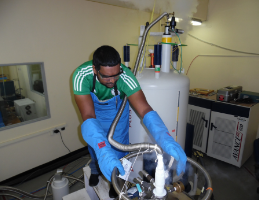
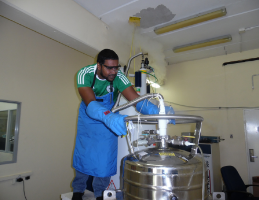
Ultra Violet-Visible Spectroscopy
Ultra Violet-Visible spectroscopy is a simple yet powerful and sensitive tool commonly used in analytical methods of analyses to detect and quantify molecules and ions.
The technique involves the absorption of electromagnetic radiation by chemical species in the ultraviolet and visible portions of the electromagnetic spectrum. The absorption spectrum provides useful information on the structure and stability of the chemical species.
The Chemistry Department is equipped with three Thermo Scientific Genesys 10S spectrometers.
The SETARAM Setsys Ev 1750 TGA-DTA/ DSC Calorimeter is an instrument that integrates Differential Scanning Calorimetry (DSC), Differential Thermal Analysis (DTA) and Thermogravimetric Analysis (TGA) to quantitatively characterize various materials under inert conditions from ambient temperature to 1600 oC. High scanning rates of 100 oC min-1 and an efficient cooling system provide a flexible range of thermal studies. Additionally, TGA-DTA and TGA-DSC can be performed simultaneously during thermal applications.
Atomic Force Microscopy (AFM)
The Chemistry Department currently has a Veeco MultiMode Atomic Force Microscope. AFM is a high-resolution technique used for the precise surface imaging of polymers, ceramics, glass, nanomaterials and biological molecules. AFM can analyze samples both in the solid and fluid state in contact and tapping mode. AFM utilizes a small amount of material and preparatory methods do not inflict damage on samples. The MultiMode system can also be used to measure frictional forces via lateral force microscopy (LFM) and it can give further information on surface features using Scanning tunnelling microscopy (STM).
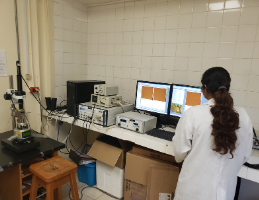
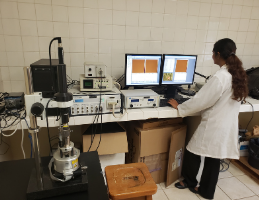
DSC
This thermo-analytical technique measures and compares the difference in the rate of heat flow of the sample with respect to a known reference material. DSC measures glass transition, crystallization, dehydration, melting point, decomposition, and other phase transitions specific to the sample. The resulting data can also be used to determine purity, specific heat capacity and thermal stability of materials.
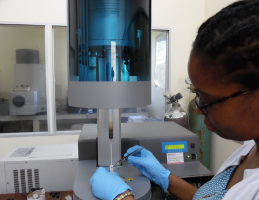
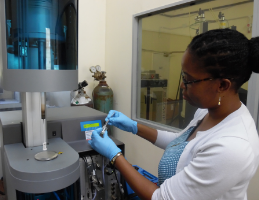
TGA-DTA
TGA is widely known for kinetic studies and this method measures the change in mass of the sample as it is heated at a chosen constant rate. Setsys Ev 1750 features a high precision balance, designed specifically for TGA. It offers unparalleled stability, is baseline independent of internal atmospheric conditions and measures up to 35g with 0.002 µg resolution to allow for the detection of minuscule weight changes in small as well as large samples. DTA measures the thermal difference between a reference sample and the sample to be characterized. Weak transitions are also recorded due to the high sensitivity of the tricouple DTA rod.
These three methods provide a plethora of opportunities to study the thermal stability and thermal properties of materials. Some applications of Calorimetry encompass:
- Food Chemistry
- Green Chemistry
- Profiling of hydrocarbons
- Catalytic reactions
- Air and wastewater treatment
- Polymers
- Clean and renewable energies
- Physico-chemical properties of material
The Perkin Elmer Spectrum 400 FT-IR/ FT-NIR (Fourier Transform Infrared Radiation and Near-Infrared Radiation) instrument measures the vibrational transitions of molecules by interaction with infrared radiation. IR is radiant or thermal energy that is not visible o the human eye but it can be felt as heat. FT-IR allows the simultaneous collection of spectral data over a wide range of wavelengths to create an infrared spectrum of the sample. FT-NIR can penetrate a sample deeply and measures infrared light that scatters within the material. It utilises an array detector that records the broad-spectrum of wavelengths without the use of a moving part and involves minimal or no sample preparation.
This spectroscopic technique identifies the functional groups in the molecules present in the material of interest. The notable range of sample accessories enables the analysis of solids, powder, liquids or pastes.
The versatility of the Perkin Elmer Spectrophotometer allows for:
- Determination of the chemical bonds and thus, the structure of a molecule
- Identification of compounds by providing a molecular fingerprint of the sample
- Detection of small quantities of contaminants in a sample
- Protein characterization
- Fast interpretation of results with the ease in use of the software
Feel free to contact us if you would like more information.






